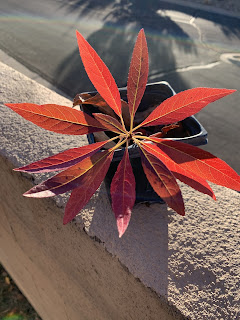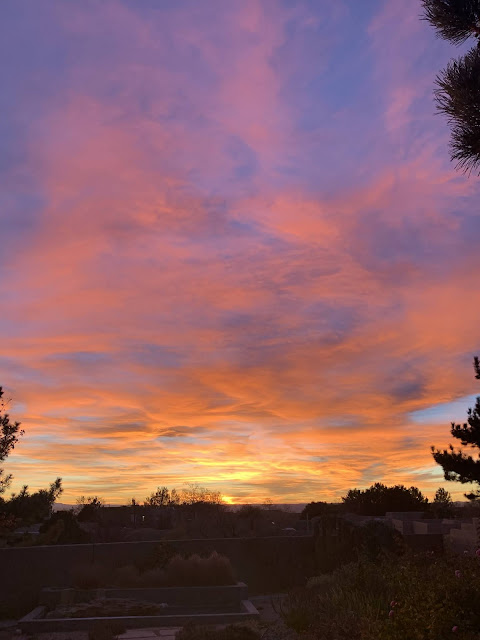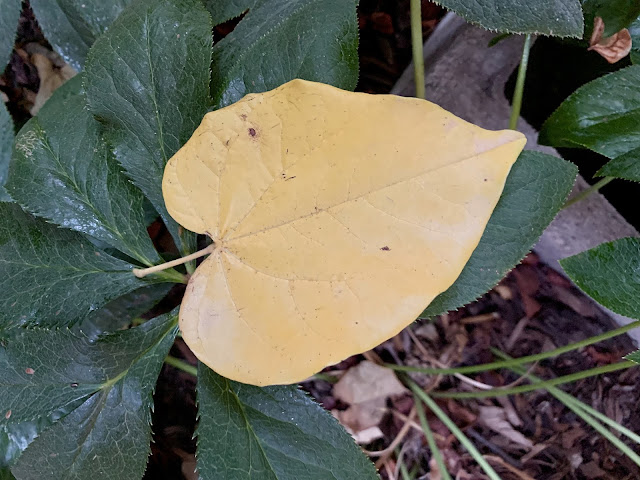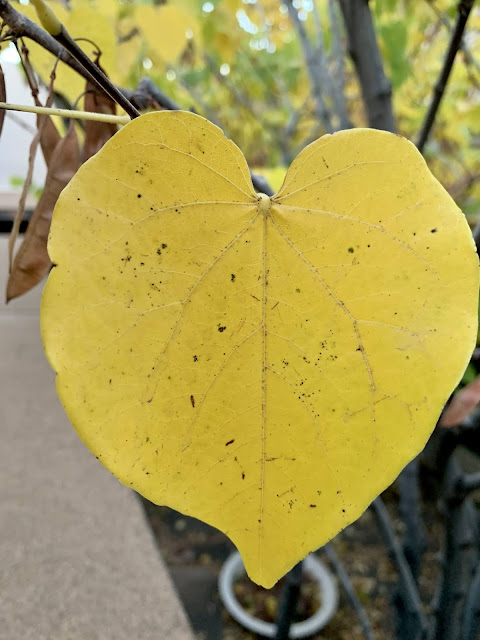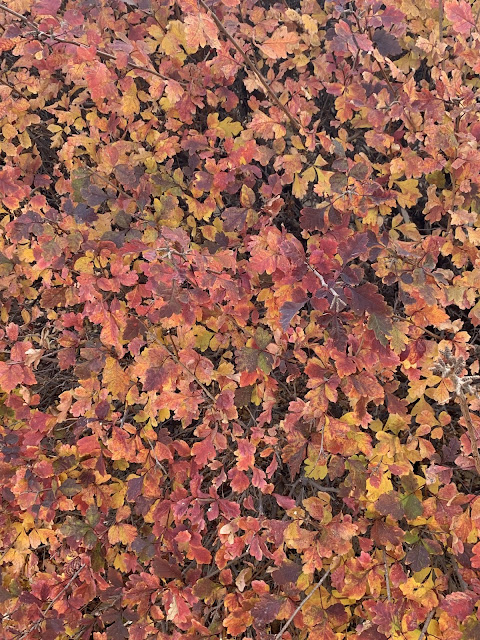Lou Sneary is an intergeneric cross between Neofinetia falcata and Rhynchostylis coelestis. I don’t have the best conditions for ‘Bluebird’ but he does his best. Although doing well in warm growing conditions, my conditions are too warm for good flowering. Because of this, flowering stems abort in the summer, and blooming is best in fall or spring. The flowers are very fragrant.
Monday, November 29, 2021
Neostylis Lou Sneary ‘Bluebird’
Lou Sneary is an intergeneric cross between Neofinetia falcata and Rhynchostylis coelestis. I don’t have the best conditions for ‘Bluebird’ but he does his best. Although doing well in warm growing conditions, my conditions are too warm for good flowering. Because of this, flowering stems abort in the summer, and blooming is best in fall or spring. The flowers are very fragrant.
Sunday, November 28, 2021
‘Huntington Rose’
There is one last flower on ‘Huntington Rose’ today. Some of the other roses also have a flower or two, last vestiges of a summer now gone. I wonder if that’s how our lives are also, barring some tragic incident or disease, do we fade hanging on to memories of glory, before those too are gone and all that is left is a withered stalk that with the next changing of season will also be gone?
Saturday, November 27, 2021
Sand Cherry ‘Sunset Ridge’
 |
| Cutting, November 27, 2021 |
 |
| One cutting didn’t turn color |
 |
| Three glowing leaves still on this one today. |
 |
| Parent plant 2021 |
 |
| Early signs of color October 22, about three weeks after color first appeared. |
They slowly changed over the next few weeks and were the much brighter color that I remembered. They also have lasted much longer than any of the sand cherries in the neighborhood. I realize that it may be a matter of culture rather than that of cultivar. But I’m eagerly looking forward to see what they do next year.
 |
| November 3, 2021 |
Wednesday, November 24, 2021
Tuesday, November 23, 2021
Aster x frikartii ‘Monch’
There aren’t many flowers left on Aster x frikartii ‘Monch’ but how many plants do you know that bloom for five months straight? I can think of a few, but it’s a very short list.
Monday, November 22, 2021
Petals
The fading roses from the last bouquet of the season have produced a lot of petals. The dried petals are a poor substitute for fresh flowers, but are a nice reminder of this past summer’s blooms. They will keep some fragrance through the winter.
‘Desdemona’
‘Desdemona’ partially backlit by the afternoon sun. I keep saying that it’s the end of the season’s roses, but they keep surprising me this year. Tonight’s temperatures are supposed to be in the 20’s tonight though.
Sunday, November 21, 2021
Osage orange time
It is a shame that Osage oranges are neither edible nor fragrant. They are also not oranges. They are cool looking though. They are actually a tree that is native to Arkansas, Oklahoma and Texas, and are tough, drought tolerant, wet tolerant, cold tolerant, wind tolerant, and tolerant of poor soil. They can be spiny, and do not have attractive flowers, and do not have colorful fall foliage. The fruit is said to repel cockroaches, but I really doubt that.
Saturday, November 20, 2021
‘Nell Lewis’ hellebore
The summer roses are finishing their show just as the first of the winter roses begin theirs. ‘Nell Lewis’ is the first one to bloom this year, this flower opened last week. ‘Jacob’ usually starts blooming around Thanksgiving and I see the buds poking up out of the drift of leaves that have fallen on him. The flowers of these, Helleborus niger, usually last through February, when the flowers of Helleborus orientalis hybrids bloom. I read a story in a gardening magazine in which the author remembers ice skating on a pond as a child, and seeing the hellebores blooming beneath the clear ice. That would indeed be magical.
Friday, November 19, 2021
Before the frost
With freezing temperatures predicted, I cut the best of the remaining rose blooms to enjoy indoors. Many of my bushes stopped blooming weeks or months ago, but some are blooming away. I learned which of my roses are most productive. ‘Bishop’s Castle’ is the clear winner. The fragrance from this bunch of roses is almost overwhelming.
Wednesday, November 17, 2021
Purple aster second show
The brief show of the purple aster flowers transforms quickly to that of the seed heads. These puffballs not only catch the wind but they also catch the low light of the season. They also last much longer than the flowers do, and will look good for months.
Tuesday, November 16, 2021
‘Old Blush’
It’s the middle of November and ‘Old Blush’ just put out a flush of blooms. It’s an unusually warm year. This is one tough rose, as it gets almost no irrigation in my yard. The color varies quite a bit through the season, starting out soft pink, then as the sun intensifies with the season the blooms flush with cerise becoming almost completely cerise as summer progresses. The blooms right now are a bit softer in color. Blooms always have a casual form.
Monday, November 15, 2021
The garden at dusk
Anything and everything in the garden is eclipsed by the sunset…for a few minutes at least. Last night’s show was spectacular.
Sunday, November 14, 2021
‘Montmorency’
This ‘Montmorency’ cherry was planted as a replacement for a poorly performing ‘Ashmead’s Kernel’ apple, and when I discovered that I can no longer eat apples. It has turned out to be much slower growing than the apple trees. It is also much more ornamental than the apple tree. None of my fruiting apple trees have a very impressive spring blossom, and that was probably a good thing since a heavy bloom would mean more thinning. The apple trees also have rather lackluster fall color. The neighbor’s sweet cherry trees also did not have a very attractive floral show or fall color, and I suspected this one would not either. Since I was planting for fruit rather than ornamental qualities, it didn’t really matter to me. But ‘Montmorency’, a sour cherry, has turned out to be stellar. Not only does it have an attractive spring show of blossoms (although admittedly not as impressive as that of ornamental cherry trees), but it has very nice fall color, shiny red bark, and a nice tree form. It also produces fruit that I can eat! What a winner! The leaves stayed green until late this year. One day there was one yellow leaf, and the next day most of the leaves had turned yellow-orange. The following day was glorious.
Saturday, November 13, 2021
Rainbow rhus
I'm not sure which sumac this is (Rhus microphylla?), but it makes these long wands which every year turn color from the bottom to the tips in a long progression of rainbow color. It's hard to photograph either an individual wand or a whole plant, since although the whole plant appears a a little fountain of rainbow wands, the wands are sidely dispersed so that they become insignificant from the distance that whole plant picture would require. It's an example of the eye appreciating more than a camera can. I look forward to seeing this shrub turn color every year, and I call it the Rainbow Rhus.
Friday, November 12, 2021
Redbuds in the fall
Redbuds are best known for their spring show of, well, red buds, but the fall show is impressive as well. My Texas redbuds (Cercis canadensis var. texensis) turn a soft yellow most years, this year being a little on the chartreuse side. In the spring, the sunlight coming through the multitude of blooms fills my courtyard with a rosy glow. In the fall, the courtyard is filled with a golden light.
Thursday, November 11, 2021
‘Munstead Wood’
I’m amazed that the roses are still blooming. This is not our usual weather pattern, although it has happened before. ‘Munstead Wood’ is looking pretty good, although I’m still considering removing one since it is not a very productive rose, and can’t take summer heat well in my west facing yard. It is much happier with this cooler weather. But this rose is not very reliable for me.
Wednesday, November 10, 2021
Rhus trilobata
The neighbor's Rhus trilobata has turned many colors, and is a sheared bush more than 5 feet tall.  |
| Three color forms of Rhus trilobata, with chartreuse Four-wing saltbush on the right. |
 | |
| This shows a dark red form, which does not look very showy in this photo, but glows when lit by the low autumn sun |
Three-leaf sumac (Rhus trilobata) has highly variable fall color. The color ranges from dark red on some plants to pale yellow on others, and many shades, blends and combinations in between. Many have a multitude of color on the same plant. Some don’t have fall color at all, the leaves just fading to brown. This dry tolerant native shrub gets to five feet tall by six feet wide or larger, especially with irrigation, and is carefree if placed with this in mind. Because of the variability in fall color, it’s best to choose plants in the fall, when the color is apparent.
Tuesday, November 9, 2021
'Osakazuki'
Acer palmatum 'Osakazuki' is famous for having some of the most brilliant fall color aof all the Japanese maples. It also has some of the largest leaves and can tolerate more heat and sun than many. In Albuquerque, it still needs a sheltered spot and regular moisture. In my yard, the leaves always look a bit ratty by the end of summer. There are better choices for this climate if you want a maple with red fall leaves, although they will look different in tree form, tree size, leaf shape and leaf size. Around town, I've noticed Acer tataricum the Tatar maple looking pretty good. The ones I've seen are multi-trunked and have a rather chunky shrubby appearance rather than the graceful upright trees of the Japanese maple. They also have more of narrow lance-shaped leaf than the hand shaped leaf of 'Osakazuki'. The Tatar maple seems to be much more tolerant of Albuquerque's heat, sun and wind than the Japanese maples. The ones I've seen have turned brilliant red in the fall. There is one called 'Hot Wings' that produces abundant bright red samaras in the summer, looking like a flowering tree. I've also seen a number of Acer grandidentatum (Bigtooth maple) hybrids or selections for sale at the local nurseries. Bigtooth maple is native to the Rocky Mountains, and is a beautiful tree, similar to a sugar maple, but smaller. It is considered by some to be a variant of the sugar maple. It would get too big for my location though. There is also Acer glabrum, the Rocky Mountain maple, which grows in the higher elevations, in mountain valleys in the Sandia mountains here. This is a beautiful tree, but variable coloration in what is available, and also would need a sheltered climate with regular moisture. I do wonder if it would tolerate the Albuquerque climate better than the Japanese maples though. There are also a number of selections that I see available in the local nurseries. My friend just planted an Acer rubrum cultivar, and it appears to be doing well in their hot south facing front yard. I probably should have planted a maple that was better adapted to this climate than 'Osakazuki' but I do love the tree form, leaves and fall color of this tree.
Monday, November 8, 2021
‘Desdemona’
The flowers of ‘Desdemona’ have become more globular with the cooler weather. The plant is slowing down also, preparing for the winter, so this may be the last of these until May. I’ve had mixed feelings about Des. The biggest problem for me is that the flowers are sometimes pink and sometimes white, at the same time, and I don’t like the combination. Also, the flowers are small. Most roses produce smaller flowers in this climate than in a milder climate, but these are smaller than I like. ‘Desdemona’ also has the quality of a more or less continuous succession of blooms, but never a lot at the same time. I’ve seen photos from people in other climates where their ‘Desdemona’ is covered with flowers, but not mine, and I have four plants in different growing conditions. But ‘Desdemona’ grows well in my garden, doesn’t get thrips damage, has good bush appearance (so far), and a great fragrance (like a gin and tonic). There is no perfect rose.
Sunday, November 7, 2021
Ornamental pear
There aren’t many plants that have as brilliant color in the fall here as the ornamental pear trees. This is because the waxy surface of the leaves allow light to get to the pigment and also help bounce the light from the pigment. This is compared to the rough surfaces of leaves (like maples and ash) which diffuse light. It is like the difference between a glossy magazine photo and a flat newspaper photo. In a wetter climate, water plays the role of the clear coat. Rough surfaced leaves can glow richly too, even here. They just need to be back-lit, and the autumn sun angle is great for that. Other waxy surfaced leaves for autumn color might include certain sumacs, burning bush (invasive weed in parts of the country). Maybe you can think of more. Unfortunately the callery pears are invasive weeds in parts of the country, but not here in the desert southwest, where it is too dry.
Saturday, November 6, 2021
'Princess Alexandra of Kent'
It's amazing that the roses are still blooming in November. Although the flowers of 'Princess Alexandra of Kent' are not perfect, they are enormous, as large as grapefruits. I've had a lot of conflict about this rose. The reviews have been mixed. Some people love this rose. Some people hate it. One person said that it grew to be a monster and didn't bloom much. She spent two days digging it out. It was with some trepidation that I planted it last year. It did not grow a lot last year, but this year it has grown vigorously. It has also bloomed well. My conflict with it is that the flowers open a garish color before fading to this soft pink which I like. That's how life is isn't it? You get the good with the bad and you have to choose whether or not it is worth it. You have to learn to live with your decisions. You can't change the past, but you can learn from your past. I can regret having planted this rose. Or I can love it. Or both. In any case, I have learned something about myself. I can choose to keep it or to remove it. I think I've already decided.
Friday, November 5, 2021
Agapanthus seed!
In all the years that I’ve had ‘Blue Yonder’ Agapanthus, I’ve never found viable seed. ‘Blue Galaxy’ was new to my garden last year and also produced no seed last year. But this year, ‘Blue Galaxy’ produced a good amount. Interestingly, there were also a few mature seeds on ‘Blue Yonder’. Yay! Maybe they cross-pollinated. Even though Agapanthus from seed is said to be highly variable, I’m curious too see how they turn out. Will they be as hardy as the parent? Could there be some seedlings that are even better than the parent? Possible, but unlikely. Still fun to try.


